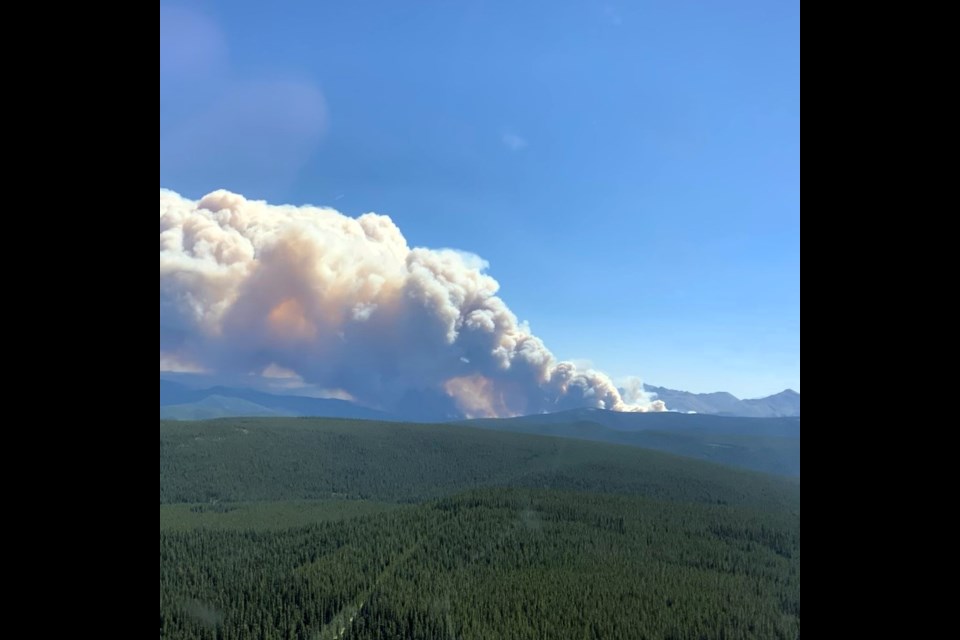ÎYÂRHE NAKODA – A wildfire continues to burn out of control near the Îyârhe (Stoney) Nakoda First Nation reserve of Big Horn.
While the fire is about nine kilometres northwest of the community, Alberta Wildfire and local emergency officials say it poses “very limited risk” to it currently.
“The fire is in a very remote area. There’s no road access, but Alberta Wildfire has been using aerial assets to attack the fire,” said Nakoda Emergency Services director Reg Fountain.
“So far, weather conditions have been pushing the fire back into the mountains and away from the Nation.”
The fire was initially assessed on July 23 and has grown to 4,936 hectares. It is burning on the west side of the Bighorn Range, about 20 km west of Nordegg, and is believed to have been caused by lightning.
Allannah McLean, fire information officer for the Rocky Mountain House Forest Area, said Alberta Wildfire was keeping a close eye on the fire when it first sparked as it’s in an area that allows for natural wildfires to rejuvenate and benefit forest ecology.
“But then it had other plans and some hot weather and pretty strong winds pushed it from being held to out of control last week,” she said.
This week has brought some rainfall to the region, which has helped control the fire and reduce spread.
“Of course, it doesn’t preclude [the need for firefighting efforts],” said McLean. “We still have work to do, but it really is helpful with efforts to get in there and make as much progress in suppressing the wildfire and reducing further spread as we can.”
Two other fires are burning in the area, further west and to the south of the Big Horn reserve. All three fires comprise what is being called the Kiska Complex.
As of Wednesday (Aug. 7), all three fires were a combined 13,894 hectares, with two of three burning out of control and the western-most fire classified as being held.
The latest Rocky Mountain House Forest Area update said there were 141 firefighters – with the recent arrival of an Australian Incident Management Team, 10 helicopters and 38 pieces of heavy equipment assigned to the complex to assist with suppression efforts.
Fountain has been working with Alberta Wildfire to keep Îyârhe Nakoda First Nation appraised of the situation. The Nation is comprised of Bearspaw, Chiniki and Goodstoney first nations, and the Big Horn reserve is home to mainly Goodstoney members.
“We have deployed a liaison team to the Big Horn reserve to assist their band staff should any further actions be required,” he said.
The team consists of two members of the Nakoda Emergency Services fire team, who will be able to work with Alberta Wildfire in its emergency operations centres if needed, including for evacuations.
Currently, no evacuations are necessary, but information will be provided should an alert or order be issued.
Wildfire danger in the Rocky Mountain House Forest Area is rated low but a fire ban is in place south of the Pembina River. Wildfire risk is based on factors such as current and expected weather conditions, but also availability of firefighting resources.
The Calgary Forest Area (CFA), which includes the Îyârhe Nakoda First Nation community of Mînî Thnî, as well as Kananaskis and the Bow Valley, was low on Wednesday following widespread rainfall.
Alberta Wildfire states that despite recent precipitation, it will take “widespread” rainfall to reduce overall wildfire danger.
“This moisture is welcomed, but after such an extended period of hot and dry conditions, the larger fuels in the forest will require additional precipitation before longer-term wildfire danger is significantly reduced,” stated the CFA.
Meanwhile, a wildfire that started on Aug. 2 near Burstall Pass in Kananaskis Country has been brought under control, and is still at an estimated 1.2 hectares in size.
Firefighters have been working on the fire for days, along with a helicopter bucketing water on the flames and air tankers dumping retardant on the wildfire, which is located in Peter Lougheed Provincial Park, about 10 kilometres south of Spray Lakes Reservoir.
The Smith-Dorrien Highway is open but Burstall Pass day-use area and surrounding trails remain closed until further notice.
Anastasia Drummond, fire information officer for the Calgary Forest Area, said investigators determined the fire was caused by lightning.
"Resources on this wildfire today include eight wildland firefighters and one helicopter for both crew movement and bucketing," she said in an update on Tuesday.
The Local Journalism Initiative is funded by the Government of Canada. The position covers Îyârhe (Stoney) Nakoda First Nation and Kananaskis Country.




